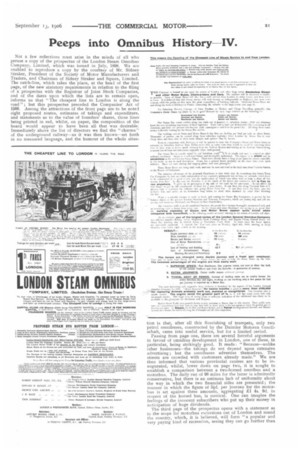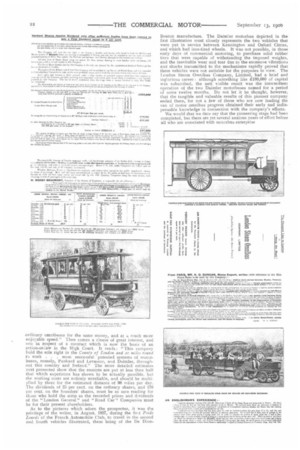Peeps into Omnibus
Page 23

Page 24

If you've noticed an error in this article please click here to report it so we can fix it.
History-IV.
Not a few reflections must arise in the minds of all who peruse a copy of the prospectus of the London Steam Omnibus Company, Limited, which was issued in July, I898. We are enabled to reproduce a copy by the courtesy of Mr. Sidney Straker, President of the Society of Motor Manufacturers and Traders, and Chairman of Sidney Straker and Squire, Limited. The catch-line, which takes the place, at the head of the first page, of the new statutory requirements in relation to the filing of a prospectus with the Registrar of Joint Stock Companies, and of the dates upon which the lists are to remain open, informs us that "The cheapest line to London is along the road"; but this prospectus preceded the Companies' Act of 1900. Among the attractions of the front page are to be noted eight proposed routes, estimates of takings and expenditure, and statements as to the value of founders' shares, these lines being printed in red, whilst, on paper, the composition of the board would appear to have been all that was desirable. Immediately above the list of directors we find the "charms" of the underground railway-as it was then known-set forth in no measured language, and the humour of the whole situa
tion is that, after all this flourishing of trumpets, only two petrol omnibuses, constructed by the Daimler Motoren Gesellschaft, came into useful service, but for a limited period.
Passing from page one, there are several forceful arguments in favour of omnibus development in London, one of these, in particular, being strikingly good. It reads : "Because-unlike other businesses-the takings do not depend upon extensive advertising; but the omnibuses advertise themselves. The streets are crowded with customers already made." We are then informed that various provincial centres are to be inaugurated, whilst, lower down on page two, it is sought to establish a comparison between a two-horsed omnibus and a motorbus. The daily run of 98 miles for the latter is admittedly conservative, but there is an ominous lack of uniformity about the way in which the two financial sides are presented; the manner in which the figure of 54.d. per journey for the motorbus is set against three amounts, aggregating £.1 4s. 9d. in respect of the horsed bus, is comical. One can imagine the feelings of the innocent subscribers who put up their money in anticipation of huge dividends.
The third page of the prospectus opens with a statement as to the scope for motorbus excursions out of London and round the country, which, it is believed, will form "a popular and very paying kind of recreation, seeing they can go further than
ordinary omnibuses for the same money, and at 4 much more enjoyable speed." Then comes a clause of great inteiest, and orw in respect of a contract which is now the basis of an action-at-law in the High Court. It reads : "This company hold the sole right in the County of London and 20 miles round to work . . most successful patented systems of motorbuses, namely, Panhard and Levassor, and Daimler, throughout this country and Ireland." The more detailed estimates next presented show that the receipts are put at Less than half that which experience has shown to he actually possible, but the worldng costs are entirely unreliable, and should be multi, plied by three for the estimated distance of 98 miles per day. The dividends of 25 per cent, on the ordinary shares, and 170 per cent, on the founders' shares, must be as sore reading for those who hold the scrip as the recorded prices and dividends of the " London General" and "Road Car 1' Companies must be for their present shareholders,
As to the pictures which adorn the prospectus, it was the privilege of the writer, in August, 1897, during the firq Folds Lourds of the French Automobile Club, to travel in the second and fourth vehicles illustrated, these being of the De Dunn.
liouton manufacture. The Daimler motorbus depicted in the first illustration most closely represents the two vehicles that were put in service between Kennington and Oxford Circus, and which had iron-tired wheels. It was not possible, in those early days of commercial motoring, to purchase solid rubber tires that were capable of withstanding the imposed weights, and the inevitable wear and tear due to the excessive vibrations and shocks transmitted to the mechanisms rapidly proved that these vehicles were not suitable for the purposes in view. The London Steam Omnibus Company, Limited, had a brief and inglorious career : although something like £180,000 of capital was subscribed, the nett visible result was the intermittent operation of the two Daimler motorbuses named for a period of some twelve months. Do not let it be thought, however, that the tangible and valuable results of this pioneer company ended there, for not a few of those who are now leading the van of motor omnibus progress obtained their early and indispensable knowledge in connection with the company's efforts.
We would that we dare say that the pioneering stage had been completed, but there are yet several anxious years of effort before all who are associated with motorbus enterprise


























